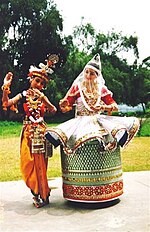Theatre and society in Manipur are intimately linked, as in many parts of the world. Manipuris are a culturally enthusiastic people. Cultural spirit has never been allowed to be blown out despite the area's remoteness from the outside world. This is why it still thrives in the Manipur valley.
Theatre has always been part of the Laiharaoba festivals since time immemorial. Theatre in Manipur today can be broadly divided, based on the texts, into religious and secular. The former is the adaptation of religious epics or some episodes from them, performed mainly in the sacred sphere such as temples. Within this Gauralila (the story of the childhood days of Caitanya Mahaprabhu), Sanjenba (an episode from the play between Krishna and his cows and his Gopis), and Udukhol (an episode from Krishna's childhood days) can be incorporated. They are seasonal performances commanding spiritual devotions among the audience.
Secular theatre is mostly confined to themes that are not religious and is performed in the secular or profane spheres. Within these are Shumang lila and Phampak lila(stage drama). Though the religious genre is loved profoundly by the audience, the torch of theatre is being held aloft by the secular ones. Among the latter also Shumang lila commands a very wide rustic popularity among the audience though the stage drama still does not lack its serene and dignified position mostly because of its community-based themes and styles. Etymologically Shumang lila is the combination of "Shumang" (courtyard) and "Lila" (play or performance). It is performed in an area of 13/13 ft in the centre of any open space, in a very simple style without a raised stage or any set design or heavy props such as curtains, background scenery, visual effects, etc. It uses only one table and two chairs, kept on one side of the performance space. Its claim to be the theatre of the masses is underlined by the way it is performed in the middle of an audience that surrounds it, leaving only one passage as both entrance and exit.
Shumang lila is performed by a touring band of 12-13 professional artists on invitation basis. These troupes may be exclusively female (Nupi Shumang Lila) or exclusively male (Nupa Shumang lila). Though the male characters are played by the female artists in the case of the former, what is most intriguing is the acting of the female roles by the male artists or nupishabis (male actresses). They are feminine in their looks, bodily gestures and facial expressions guised in masculine souls.
Historically the seed of Shumang lila was sown in Phagee lila (farce), performed during the reign of Ningthourel Chandrakirti (1850–1886), though traces of it were already present in the episode of Tangkhul-Nurabi Loutaba of Laiharaoba festival. Then it was succeeded by such plays as Ramlila, Sabha parba, Kabul lila, etc. But the real Shumang lila with various rasas (sentiments) was ushered in with the epic playHarishchandra (1918). Then it was followed by others such as Meiraba charan, Thok lila, etc. One of the most successful of this era was Moirang parba, an epic play based on the legendary lovers Khamba andThoibi of Moirang.
On the other hand, the world of Phampak lila (stage drama) performed in the proscenium theatre is similar, in form, to the Western theatrical model and Indian Natyasastra model though its contents are indigenous. The so-called modern theatre descended on Manipuri theatre culture with the performance of Pravas Milan (1902) under the enthusiastic patronage of Sir Churchand Maharaj (1891–1941). The pace of theatrical movement was geared up with the institution of various groups such as Manipur Dramatic Union (MDU) (1930), Arian Theatre (1935), Chitrangada Natya Mandir (1936), Society Theatre (1937), Rupmahal (1942),Cosmopolitan Dramatic Union (1968), and the Chorus Repertory Theatre of Ratan Thiyam (1976). These groups started experimenting with various types of plays apart from historical and pauranic ones. Today Manipuri theatre is well respected because of various excellent productions shown in various parts of the country and abroad. Manipuri plays, both Shumang lila and stage lila, have been a regular feature in the annual festival of the National School of Drama, New Delhi.
Manipuri dance (Ras Lila)
A classical form of Manipuri dance based and inspired by the theme of Lord Krishna and his beloved Radha's love story and the devotion of the Gopis (companions) toward Lord Krishna. This graceful and slow movement of the dance makes it one of the most acclaimed classical dances of India. The costume is elegant, as there are nicely embroidered clothes that give luster to the beauty of the art.This dance is very exciting dance.
Chorus Repertory Theater
The auditorium of the theater is situated on the outskirts of Imphal and the campus stretches for about 2 acres (8,100 m2). It has housing and working quarters to accommodate a self-sufficiency of life. The theater association has churned out internationally acclaimed plays likeChakravyuha and Uttarpriyadashi. Its 25 years of existence in theater had disciplined its performers to a world of excellence. Chakravyuha taken from the Mahabharat epic had won Fringe Firsts Award, 1987 at the Edinburgh International Theater Festival. Chakravyuha deals with the story of Abhimanyu (son of Arjun) of his last battle and approaching death whereas Uttarpriyadashi is an 80-minute exposition of Emperor Ashoka's redemption.



No comments:
Post a Comment